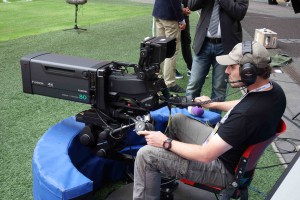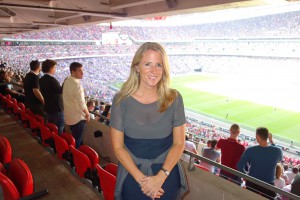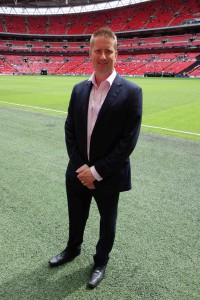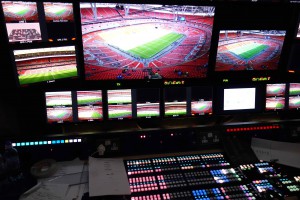Live from Wembley: BT Sport launches new 4K Ultra HD broadcast television era
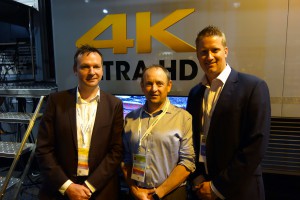
4K UHD leaders (L/R): Jamie Hindhaugh, BT Sport; Dan McDonnell, Timeline TV; and Andy Beale, BT Sport
The biggest game-changer in European sports broadcasting in 2015 has taken place with the launch of the BT Sport Ultra HD channel on August 1, followed by the first live exclusive 4K match-day production on August 2 at the FA Community Shield between victorious Arsenal against Chelsea. What was previously a much-debated possibility – live UHD TV broadcasting — has been turned into a reality by BT Sport and its partners. August 1 in fact saw the launch of three channels by BT Sport: in addition to Ultra HD are the new BT Sport Europe and BT Sport Showcase channels. The timing of the launch relates to BT Sport’s successful bid to become the sole UK rights holder for all 351 games of the coming UEFA Champions League and Europa League season.
In preparation for Ultra HD, Timeline Television built a bespoke OB truck in collaboration with BT Sport. UHD-1 has been constructed from the ground up featuring the highest quality 4K workflow available including the first deliveries of Sony’s new HDC-4300 2/3 inch UHD 4K camera; the world’s first Fujinon UHD 4K 2/3inch 80:1 box and 22:1 ENG lenses; and a Snell Kahuna UHD 4K switcher with Sirius router.
BT Sport invited SVG Europe to Wembley to learn about the groundbreaking journey to becoming an on-the-air live UHD broadcaster and to tour UHD-1 on its maiden FA Community Shield broadcast. We discussed this ‘Ultra HD Phase One’ journey with Andy Beale, BT Sport Chief Engineer; Jamie Hindhaugh, BT Sport Chief Operating Officer; and Daniel McDonnell, Timeline TV Managing Director.
Jamie Hindhaugh: Today is the first 4K live stream into the home of a football match in Europe. So it’s a fantastic opportunity for us: we’ve had a big weekend launching three new channels yesterday as well.
We are the first broadcaster in Europe to be doing 4K. And considering we’re only two years old as a broadcaster yesterday [BT Sport launched on August 1 2013], it’s really a big story for us. As soon as we launched our channels two years ago, one of our key challenges was ‘how do we make the experience even better for the consumer? What is in the market that can do that?’ It’s not about gimmicks, it’s not about new technology for technology’s sake. It’s about how we can give that sense of presence; how we can really enhance that shared experience when you’re watching a live football game. For us, 4K does all of that. It’s very natural how you shoot 4K, and it’s very natural how you view 4K within your brain — compared to other formats that have been tried in the past.
So we identified that as an aspiration, and then we secured exclusive Champions League and Europa League rights [for the UK]. When you’ve got something that exclusive, you start to tie that into setting your challenges about when you want to be able to bring forward that new format. This is why we’re launching now.
One of the key enablers is the fact that we work for BT, which has got a fantastic IP broadband infrastructure that enables us to deliver 4K over IP into the household that has Infinity [BT fibre optic broadband]. We also have a division within BT called BT Media & Broadcast, and they provide the links communication between the truck and BT Tower; they have developed the 4K links truck capability that gets it to the Tower.
A key element for us is, how can the consumer who has a 4K smart TV actually get the 4K picture on their TV? We’ve worked with YouView and Humax to develop a new-generation G5 4K box as well. So you get your 4K TV, your 4K box, Infinity — and then you can get glorious BT Sport in 4K! Football is a key driver, and today is a big step for us.
Take-up [of Ultra HD] is going to be low, we know that. But broadcast innovation is really important: our whole aim for 4K is not about our own self-congratulation, it’s not about getting one over on our competitors. Actually the whole ethos of BT Sport is how do how do we get the best pictures, the best experience, to our customers.
It’s been an intense weekend for BT Sport with the launch of the three new channels, and now today the first 4K UHD coverage of a live football match here at the FA Community Shield. Are you happy with the way everything has gone?
Jamie Hindhaugh: I’m thrilled with what we have done. To be honest, it was easier than when we launched three channels two years ago. You could argue that’s because we’ve already got the channels and we’re overlaying new ones now: but it’s because we’ve got a great team. We’ve got the experience to pull it off.
Yesterday was a fantastic day; we went live at 6am with a whole new graphics look on BT Sport
Europe. We launched our first Freeview channel at midday, and have the capability now to do seven linear red buttons and several connected red buttons through IP delivery – so you’ll see a whole new look and feel for the Champions League. We’ve rebuilt our studios, so when you see Champions League for the first time on 15 September you’ll see augmented reality and you’ll see 4K projection like you’ve never seen before: it’s quite special. It’s a bit of a rollercoaster at the moment, but it’s fun!
When you made the decision to set this August 1 2015 target to go on air with UHD 4K, it’s fair to say the industry was simply not geared up to supply all the parts of the chain you were going to require. You must have had to really push partners and suppliers very hard to meet the deadline?
Jamie Hindhaugh: We started our 4K journey about 19 months ago. So we weren’t satisfied with just coming on air back then, we started planning ahead. Really key partners – and they’re not here today – are Telegenic: we’ve worked very closely with them and their 4K capability, and with Timeline. It’s similar to when we did our launch in 2013 at such speed: our strength was our relationship with key partners within the industry.
Telegenic are still very much part of our story; we’ve just contracted with them to be our main OB provider now, across Champions League, Europa League and our rugby. What we’re now doing with them and with Timeline is working together to enable us to build the story around 4K.
Our aspiration is to work with all our partners to make sure this is the shining example of how one truck can do both HD and 4K formats – the Telegenic truck can’t at the moment. It’s how we evolve that to really build the 4K story – to take us on that journey — but also meet our HD obligations.
The truck is fully funded by BT Sport, so it’s a complete partnership where we’ve worked together with Timeline in commissioning and co-design. Andy was involved with the design of the workflows, and the relationship we have is that this is our truck, but we allow them to use it for other broadcasters etc if we’re not using it, on a four-year deal.
Andy Beale: We used Telegenic for most of our test events, which got us to the point where we were comfortable to commit to doing this project. This truck has been designed especially as we knew that for the first couple of years, it would need to sit alongside our HD production.
It’s a very compact unit, the largest we could get into a rigid body, not articulated. It was designed very specifically for that purpose, so that when we get to some of the smaller sports grounds we can squeeze it in. Telegenic didn’t have a vehicle in that space; it isn’t really their market. Some OB compounds in smaller grounds are very tight; we wanted to be able to park alongside the main scanner. And we’ve also considered some of the other sports, or other markets, we might want to sell the truck into – perhaps such as opera – that have very tight parking spaces.
Jamie Hindhaugh: You can say the relationship between BT Sport and Timeline is fantastic. From the birth, you can look at the technical infrastructure we have over in Stratford; a lot of the capability here mirrors what we have in Stratford, so it was a natural evolution to work with those partners who are on site every day to build this [truck], and to be honest I think the relationship is going from strength to strength.
So many elements have had to come together to meet this hard August 1 on-air deadline. What’s been the biggest challenge on the journey?
Jamie Hindhaugh: There are four main challenges: having the correct outside broadcast capability with camera and lens configuration; the distribution to the set-top box; the set-top box itself; and then of course the migration of people to 4K TVs. I think smart technology has helped drive the latter, so people are upgrading because of all the smart capabilities that come with that.
So it was a perfect storm of putting all those elements together – all overlaid with the fact that we had a fantastic set of rights coming on line with the Champions League. This Champions League overlay is what set the timeline. You only get one opportunity to be the exclusive broadcaster for the Champions League in the UK; everything worked back from that.
Andy Beale: From our perspective, the things we had to get green lights on to give us the confidence to go were confidence that the two-thirds inch chip cameras were going to be available by August 1; confidence the lenses to go with those cameras were going to be here (and other elements like Axon tookits and the Snell switcher); and confidence that the chip-sets were available for the set-top box.
The network we were always confident in; [BT Group CEO] Gavin Patterson said years ago, “we’re building this network. Why? TV”. We don’t really need superfast broadband in the home for Facebook and YouTube. It’s all about next-generation TV.
Jamie Hindhaugh: There’s nothing like a deadline. I like deadlines. Deadlines help. And the other thing is, I’ve been going to NAB and IBC for the last few years and everyone’s bloody talking about 4K TV but no one was really doing it! It got to that stage where you could see that manufacturers and technical experts needed a catalyst like us, and I think we’re going to really drive this forward now. There is an avenue, and other people are starting to look at it. We are seeing that viewers do want it, actually.
Andy Beale: For us, where we are right now with Ultra HD phase one is perfect. Consumers are buying the TVs, and we want to bring the very best sports rights in the best possible quality available right now to our customers. The other things that people are talking about waiting for, they’re three or four years away; they’re not going to be available in this rights cycle.
Jamie Hindhaugh: We also want to use this opportunity to showcase a range of rights as well, because it’s so immersive. So we’re doing the first three Premier League games as the season kicks off, in UHD. We’re doing Rugby Aid, which is England against Rest of the World from Harlequins. We’re doing the Moto GP – for the first time in the world, absolute coverage of Moto GP in 4K from Silverstone at the end of August. Then we’re doing squash, and the NBA from the O2.
I should add that all of the rights-holders have been really supportive, and that’s very important, because within HD when you have your rights contracts there are minimum camera specifications and obligations around the world feed. But all of our rightsholders are working with us to allow us to give them certainty that the world feed etc., if it ever did move to native 4K with downres to HD, that it would satisfy those requirements.
Andy Beale: In terms of technology choices, the beautiful thing about this truck is that it can dock straight into our technical infrastructure at Stratford. For example, with the Riedel talkback we’ve chosen, we can plug the truck into a loading bay we can hook it into our talkback matrix and it can join the whole infrastructure. The Calrec desk can join our MADI infrastructure.
We’re not planning to do it yet, but if we wanted to do a UHD studio production we can roll this in, put power in, and this truck becomes part of our core infrastructure. Plus we can common spares holdings now, across router, Calrec and talkback; one set of spares drives not only our studios but also this truck. There are lots of good efficiencies.
So let’s talk about the truck. Dan, it’s fair to say there are a number of firsts on board – including the Sony 4300 cameras and Fujinon UHD box lenses?
Dan McDonnell: It’s been an incredibly tight turnaround. It took 26 weeks to build the chassis. While that happened we selected technology: Andy and I worked closely together to build up everything we have now. We did build a test solution, but this is the first time it has been used in its new configuration.
Yes, we’ve got the first twelve Sony 4300 cameras in the world and they’ve got serial numbers zero-zero-one to zero-zero-twelve! We put in the first order and got the first cameras. And yes we’ve got six of the brand new 80:1 box lenses and six 22:1 ENG lenses, and they arrived on Thursday. No-one has used these before.
Andy Beale: We had early development models of the 4300 and the box lens back in March. We tried those out to give us confidence. We had a backup plan in the form of F55s and HD lenses with adaptors so we weren’t too worried – but of course we wanted the best cameras and lenses.
Dan McDonnell: Yes we definitely pushed them. When we asked Fuji for the lens they said, ‘well when do you need it for?’ This date was ahead of their original delivery date, so yes BT has definitely forced everyone to push on and get this working. And we have got everything we wanted.
What’s the 4K production camera configuration here at Wembley today?
Dan McDonnell: Two cameras in the gantry, one and two; two 18-yard cameras and a hide-behind; low at each side; a beauty shot; and we’re actually doing 4K in the presentation from the commentary box. The commentators can turn around and do all of their introductions and analysis to a 4K camera. Everything is native 4K.
We’ve got 4K Chyrons on the back row, for full graphics. And in the VT area we have six 4K EVS’ handling all of our replays. The only two areas we can’t yet achieve are a 4K radio camera and a 4K super-slow camera – both of which are in the pipeline to have ready in time for Silverstone Moto GP. Vislink are making a H.265 encoder to allow us to get the 4K signal within a 20 MHz slot, which is the bandwidth of two HD radio channels joined together. With H.265 we can get very good quality.
The Sony 4300 cameras we have can do up to eight times super slo-mo in HD already. We have tried that and it works fine. At IBC they’re releasing code to allow us to do two times super slo-mo in 4K. Then we will have a two-time super slo-mo camera that will go into our EVS.
At the moment we’ve got 12 cameras and six EVS’ that can do two each – so we can do normal speed replay. The I-Movix is not really designed to do your first replay: it’s more tailored towards showing great shots or further analysis, if you’ve got a bit of time. It’s not your ‘bang, there’s a goal’, which is what we really want — and It’s coming, we will have it very soon.
Talk us through the main production area here in the truck.
Dan McDonnell: The centrepiece is the Snell Kahuna, a 120-input mixer that can do what they call Format Fusion on all its inputs. So it can take in any combination of 4K and HD sources, and uniquely if you put in 4K that signal goes straight through; if you put an HD signal into the mixer it upconverts it for the 4K output, but for the HD output it doesn’t do any conversion at all, just passes it through.
So we minimise any up and down-conversion between standards. The only source we have in HD is Hawkeye for goal-line decisions, so that goes into the mixer and is upconverted to 4K.
And we’ve got a Sony 4400 server replacing a tape machine if you like; we’re recording into that and streaming to a drive which we can then take back to Stratford. And all of the EVS [replays] go into that drive as well. This is an entire end-to-end 4K workflow, and the brief from Jamie was to be able to do a 4K football match to the same quality as HD.
We can do all of the little things like replay box in the corner with replay, wipe and graphics, so we end up with seven 4K keys over our picture. It’s a huge amount of processing power and a very large Snell matrix, because obviously every single input has four cables wrapped around it.
And Axon is the glue. The Axon cards they built and developed for us – which again we only received in the last couple of weeks – are doing the clever embedding and line routing. The control systems chosen is Axon Cerebrum. Rather than use bespoke Snell panels to control the matrix, we’ve got Axon Cerebrum controlling all of the matrix, all of the glue and lots of other pieces in the chain.
You can see in the VT area we don’t have panels for the VT operators; we’ve got 10-inch
touchscreens, so that you can do very complicated routing really easily. We’re recording sixteen audio tracks with all the different Dolby information. We can actually control all of that with the press of a button now – which is so much easier. It’s an amazing system. We have a very similar system in Stratford with BNCS, and this is like a mobile version of that. Some other trucks have already got Axon Cerebrum; but I think we’re the first people to take the touchscreen and not just replace the hardware with another hardware panel, we’ve actually embraced the whole advanced control. There are so many functions of something like a 4K toolkit, taking in the four 4K signals and then embedding the Dolby in it — there are so many parameters you can control, that doing it on a hardware panel is very difficult.
The director’s monitor is a domestic £2,000 Sony 49-inch ultra high definition 4K television that you can buy for your home. This is very important because in the tests we did, we discovered that the director really needs to be able to see what the people are seeing at home.
The whole essence of 4K is that you’re watching it on a big telly: and if the director is not watching it on the same screen he’s not sharing the experience. That’s a key change to most other current OB trucks.

